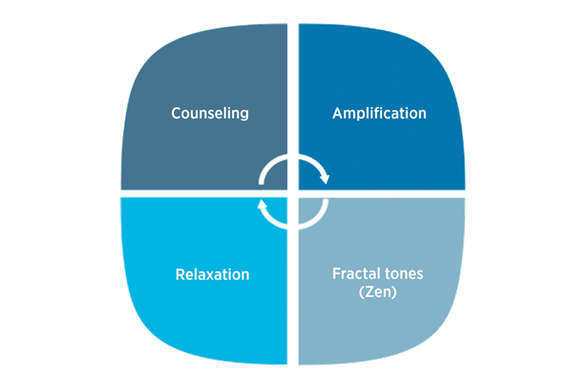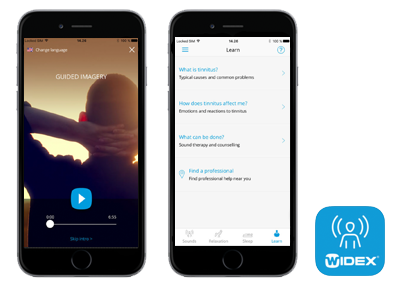About Widex Zen Tinnitus Therapy
Widex introduced its tinnitus therapy and management tool in 2012. Widex was the first hearing aid manufacturer to offer a full tinnitus management protocol. Today, there are many tinnitus treatment options on the market.
Some are offered by hearing aid manufacturers and others from outside the industry. It can be confusing, especially for the consumer suffering from tinnitus.

This article is not intended to compare all the various options available, We will try to explain the Widex Zen Therapy protocol by presenting a brief introduction to what Widex Zen Therapy is.
We will then discuss Widex’s latest offerings, which include an updated Widex Zen Therapy – Tinnitus Management App.
Tinnitus Facts
Tinnitus is a common, persistent symptom characterized by a sound sensation in the “ears” or “head” not produced by acoustic sounds from the external environment.
A recent epidemiological study based on 1,960 interviews conducted in the city of São Paulo, Brazil, showed that 22% of the inhabitants had some form of tinnitus, a higher prevalence than the 10–17% value commonly reported in the literature. They also observed that the prevalence of the symptoms increases progressively with age and can be three times higher in the elderly (36% over 65 years of age) than in young adults (12%). Many tinnitus sufferers also exhibited hearing loss and extra sensitivity to loud sounds.
Various pathophysiological causes underlie tinnitus, and all of the associated symptoms interfere with evaluations of affected patients. Medical management and appropriate counseling suffice; however, for other patients, the symptoms are persistent and bothersome, and they interfere with daily activities and the quality of life.
A recent U.S. study found that nearly a quarter of those who reported tinnitus symptoms described it as disabling, and according to Brazilian data, ∼ 34% of cases are severely annoying.
Different forms of sound therapy are available for the relief of tinnitus, and several forms of stimuli can be delivered from sound devices, which can be combined with hearing aids. Tinnitus primarily occurs because of sensory deprivation and increased central neural activity.
A hearing aid can restore this system and is an effective treatment that has been confirmed by several studies. Other studies have revealed that music has great therapeutic potential for tinnitus relief. Listening to music leads to relaxation and stress relief, both of which can contribute to tinnitus control. In patients suffering from tinnitus, the presence of an annoying, persistent, and uncontrolled out-of-context sound signal can increase stress levels and cause an emotional disturbance that can exacerbate the perception of tinnitus.
Neuroimaging has revealed the brain structures involved in tinnitus perception, which include the hippocampus, limbic area, frontal lobe, and cerebellum. These areas are also highly activated when listening to music. Music can be customized and filtered in accordance with the individual’s hearing loss and tinnitus pitch and listening to pre-recorded music provides the patients with a structured listening protocol.
Tinnitus isn’t a condition itself, it is a symptom of an underlying condition, such as age-related hearing loss, ear injury, or a circulatory system disorder.
Tinnitus may be present all the time, or it may come and go. Although bothersome, tinnitus generally isn’t a sign of something more serious. Tinnitus can worsen with age. Treating an identified underlying cause can sometimes help. Other treatments can reduce or mask tinnitus, making it less noticeable.
Symptoms
People describe tinnitus in their head or ears as hearing the following:
Ringing. Buzzing, Roaring, Clicking, Hissing, Humming, and Music.
Tinnitus can vary in pitch from a low roar to a high squeal and may be heard in one or both ears. In some cases, the sound can be so prominent that it may interfere with one’s ability to concentrate or hear environmental sound.
The American Tinnitus Association estimates that over 50 million Americans experience tinnitus. Of those, many also suffer some amount of hearing loss. Many may not even be aware of the hearing loss, or it isn’t their primary concern; the tinnitus is.
When hearing loss is present, there is reduced neural stimulation presented to the auditory cortex (the hearing processing part of the brain). The current consensus about the origins of tinnitus is that this lack of stimulation (auditory deprivation) will cause the brain to overcompensate for the lack of stimulation, and cause extra activity or neural impulses in the brain, which the brain interprets as sound.
Many people who experience tinnitus will naturally get used to it (habituation). Many get used to all types of sounds during their daily lives. An example could be not being bothered by traffic noise, even if living near heavy traffic. Some tinnitus sufferers are not able to get used to or accept their tinnitus, and this can negatively affect their quality of life.
Zen Tones
Before we get to the process of Widex ZEN Tones (WZT), let’s discuss “Zen Tones“. Zen tones, as the name might imply, were first introduced to offer the possibility of activating a relaxation program in Widex hearing aids.
What is special about these tones is that they are based on musical properties. Music can induce relaxation, by eliciting a physiological response; but on the other hand, music can also stir up negative emotions or can grab our attention and distract us. In some cases this might be a good thing (or not), in the case of tinnitus management, we want tinnitus suffers to achieve habituation (acclimation).
To achieve habituation, Widex needs to ensure that the person listening to the tones does not get hooked on them. That is, we want them to listen to the Zen tones, passively, as opposed to actively. So, for that reason, Zen tones were designed using fractal technology, and they mimic the properties of music, the musical “rules”, so to speak, but without being predictable, or eliciting emotion.
Fractal tones are harmonic and melodic tones that sound like “wind chimes”; however, because they are not predictable, these tones cannot be associated with any other conventional music to which the patient may have been previously exposed. This unpredictability is a unique and desirable feature of fractal tone music sound therapy because it induces passive listening, which is required for habituation.
Habituation represents a natural brain function designed to reduce neutral stimulus perception under repeated exposure. Recent studies have shown that the use of fractal sounds may represent a viable alternative for minimizing the annoyance caused by tinnitus. Fractal tones appear to lead the listener to a pleasant and relaxing auditory experience and induce greater relaxation and stress relief compared with conventional music.
Fractals can generally be defined as something with a never-ending pattern, so when applied to Zen tones, it means that the melody generated will never be the same. This is a fairly innovative solution.
With the success of the Zen tones with tinnitus management, Widex decided to build a full tinnitus management protocol, of which the Zen tones would be an integral part. Since sound stimulation is such an important part of managing tinnitus, it made sense for Widex to develop a protocol and incorporate the fractal sound generator (the Zen tone, of course) in the hearing aids themselves.
Widex teamed up with Dr. Robert Sweetow, an expert in the field of tinnitus management, and Widex Zen Therapy was born. Widex Zen Therapy is also known as an integrated tinnitus management protocol because it integrates four individual components, which can be utilized all together, alone, or in any combination; as long as it meets the client’s needs. So let’s look into this in more detail.
Widex Zen Therapy (WZT)
As mentioned before, the main objective of the Widex Zen Therapy protocol is to ensure that tinnitus does not negatively affect the client’s quality of life. How to achieve that? Well, let’s look at the four components of WZT:
- Counselling
- Amplification
- Zen tones
- Relaxation
Depending on the needs of the individual, the clinician can assess which of these components should be part of the treatment plan.

When tinnitus sufferers make their way to their hearing care professional for guidance about what to do about their tinnitus, they may have varying degrees of “reactions” regarding their tinnitus.
Some may have a very strong negative reaction, but many will just be slightly or moderately bothered by it.
We need to determine how much tinnitus is affecting one’s quality of life. For clients who don’t have a significant emotional reaction, counseling about the origins, cause and course of the tinnitus, plus amplification (if a hearing loss is present) may be enough.
The hearing aid will provide sound stimulation, which helps reduce the contrast between their tinnitus and the silence, and for some people that might be enough to start paving the way towards habituation.
Others might have a stronger negative reaction and may be feeling stressed or anxious, and get caught in the vicious tinnitus-stress cycle.
The individual contributions of fractal tones on chronic tinnitus sufferers determined that the main benefit of this approach was in the Tinnitus Handicap Inventory (THI) functional domain, which includes concentration, reading, attention, consciousness, sleep, social activities, and household tasks. For all patients with bothersome chronic tinnitus who have high scores on the THI functional scale, fractal tones should be considered as good initial sound therapy.
WIDEX ZEN – Tinnitus Management App
This app can be used in two ways: as an educational & sound stimulation tool or as a supplement to a treatment plan.
The app can help reach those who have tinnitus but who either don’t have hearing loss or have not yet made the step to treat their hearing loss.
The app contains new sounds, including new Zen tones, exclusively found on the app. Finally, the app also contains general information on tinnitus, relaxation exercises, and sleep management exercises, each with Frequently Asked Questions sections.

The ZEN app is currently available in the USA and other selected countries. To find out if the app is available in your respective country, please check your App Store/Google Play store, or ask your HearSource representative.
This article discussed Widex Zen Therapy, a tinnitus management protocol developed by Widex and Dr. Robert Sweetow. WZT is an integrated tinnitus management tool and consists of four core components: Counselling, Amplification, Zen tones, and Relaxation.
For more information contact your HearSource hearing professional.
Here is an additional link to a research study: Clinical Trial on the Effectiveness of Widex Zen Therapy for Tinnitus






